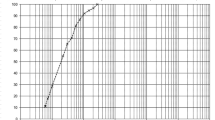Abstract
The study of water flow through soils is an important aspect of soil mechanics. Past experience with glacial clay till deposits investigated in central and southern Saskatchewan has demonstrated that in situ saturated hydraulic conductivities vary from about 10−6 to 10−9 cm/s. In some applications and regulatory references, an accepted practice in the past is to assume that the field hydraulic conductivity value for a soil liner will be one order of magnitude (i.e. ten times) greater than the confirmed laboratory hydraulic conductivity value for a remoulded sample composed of the same soil. In fact, experience has shown that measured as-built field hydraulic conductivity values for a soil liner can be several orders of magnitude greater than the laboratory value if the liners are poorly constructed and, therefore, would not be compliant with regulatory criteria. The reliability of artificially applying any correction factor to a laboratory value to obtain an assumed field value is, therefore, questionable. This paper describes field and laboratory investigations that were conducted to characterize the general properties and the hydraulic conductivity of a glacial clay till soil liner. For this example case study, laboratory measurements of the hydraulic conductivity for remoulded soil samples were undertaken using a flexible wall permeameter (FWP). Air-entry permeameter (AEP) tests were performed on a soil test pad prior to construction and then on the completed soil liner immediately after construction to measure the as-built hydraulic conductivity. Both the FWP and AEP tests resulted in comparable hydraulic conductivity values that were in the order of 10−8–10−9 cm/s. A preceding and preliminary empirical approach was also found to be reasonable for purposes of determining soil suitability and estimating the “achievable” hydraulic conductivity value. The preliminary estimate was determined to be conservatively greater than the values determined by both the FWP and AEP test methods.









Similar content being viewed by others
References
Benson CH, Daniel DE (1994) Minimum thickness of compacted soil liners: II. Analysis and case histories. J Geotech Eng 120:153–172
Daniel DE (1984) Predicting hydraulic conductivity of clay liners. J Geotech Eng 110:285–300
Day SR, Daniel DE (1985) Hydraulic conductivity of two prototype clay liners. J Geotech Eng 111:957–970
Detmer DM (1995) Permeability, porosity, and grain-size distribution of selected Pliocene and Quaternary sediments in the Albuquerque Basin. New Mex Geol 17:79–87
Elsbury BR, Sraders GA (1989) Building a better landfill liner. Civ Eng 59:57
Fernuik N, Haug M (1990) Evaluation of in situ permeability testing methods. J Geotech Eng 116:297–311
Gordon ME, Huebner PM, Miazga TJ (1989) Hydraulic conductivity of three landfill clay liners. J Geotech Eng 115:1148–1160
Hazen A (1930) Water supply. American civil engineers handbook. Wiley, New York, pp 1444–1518
Kodikara J, Rahman F (2002) Effects of specimen consolidation on the laboratory hydraulic conductivity measurement. Can Geotech J 39:908–923
Lambe TW (1951) Soil testing for engineers. Soil Sci 72:406
Milan V, Andjelko S (1992) Determination of hydraulic conductivity of porous media from grain-size composition. Water Resources Publications, Littleton, Colo
Purdy S, Peters J (2004) Comparison of hydraulic conductivity test methods for landfill clay liners. In: Paper presented at the Beacon Conference, Buenos, Argentina
SAFRR (2005) Saskatchewan Agriculture, Food and Rural Revitalization—Site characterization manual for the development of intensive livestock operations and earthen manure storage. Saskatchewan, Canada
USEPA (2000) United States Environmental Protection Agency—Guide for industrial waste management. Diane, Darby
Author information
Authors and Affiliations
Corresponding author
Rights and permissions
About this article
Cite this article
Saadeldin, R., Froc, G. Hydraulic conductivity of a glacial clay till liner. Bull Eng Geol Environ 76, 553–560 (2017). https://doi.org/10.1007/s10064-016-0977-0
Received:
Accepted:
Published:
Issue Date:
DOI: https://doi.org/10.1007/s10064-016-0977-0




